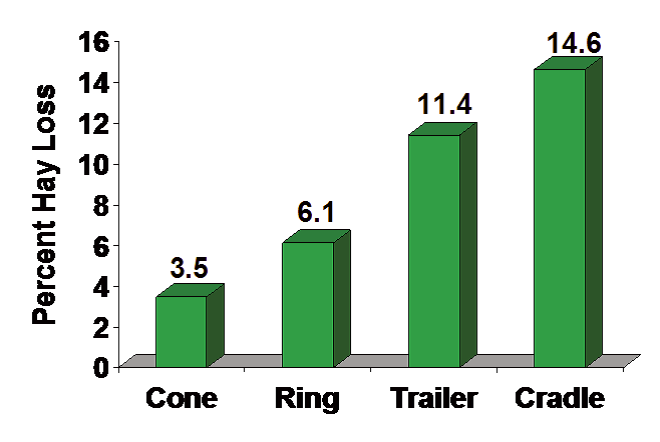By Mark Mauldin
The cooler temperatures and shorter days associated with the transition from summer to fall can be a welcome change when working outside. However, it is a mixed blessing for Panhandle cattle producers. As temperatures decrease and day lengths shorten, perennial warm season pastures (upon which area cattle operations are built) begin to go dormant. Dormant pastures cannot meet the nutritional needs of the herd, and therefore, supplemental food and nutrition must be provided in some other way. Cured hay is commonly used to fill the winter nutritional deficit.
Hay is an expensive feed whether grown on the farm, or purchased off-farm. Area hay prices range in the vicinity of $100/ton (purchased hay). Mature cows require 20-30lbs./head./day during the winter feeding period. Growing or purchasing hay for a herd, for the entire winter, is a sizable investment. To help keep hay costs manageable, it is imperative that producers minimize the amount of hay lost or wasted.
Hay losses come in two main forms; dry matter (DM) and nutritional quality. Dry matter losses refer to the decrease in the physical amount of hay present and available for consumption. Nutritional quality refers to the specific nutritional value of the hay, such as total digestible nutrients (TDN), or crude protein (CP). See the UF/IFAS publication Forage Testing for more details on nutritional value of hay. This article will focus on ways to manage DM losses in hay. Dry matter losses will generally fall into one of two main categories; storage losses and feeding losses.
Storage losses, as one may expect, are any reduction in DM from the time the hay is rolled or baled until the hay is fed. The first factor impacting the severity of storage loss is the moisture content of the hay at baling. All hay will lose some DM in the weeks immediately after baling. The dryer the hay is at baling the lower the expected DM loss will be. Hay dried to 15-20% moisture prior to baling should have minimal DM loss, whereas hay baled with over 20% moisture has the potential for considerable DM losses. In the case of high moisture hay DM losses will be accompanied by decreased nutritional content and palatability. There is also an increased risk of fire when high moisture hay is stored. For these reasons it is crucial that adequate drying occurs prior to baling. For a more detailed explanation see: Hay Storage: Dry Matter Losses and Quality Changes.
How and where hay is stored after baling also has a significant effect on the amount of DM lost. Protecting hay from the environment, especially moisture is crucial to prevent DM loss. A worst case scenario would be bales wrapped with twine and stacked uncovered directly on the ground. This scenario could result in over 25% DM loss in one year. Ideally, hay bales would be completely protected. This protection could come from a permanent structure like a barn, or from more individual/temporary measures like bale sleeves or individual wrapping in plastic wrap. These forms of protection reduce DM storage losses to around 5%. The publication Round Bale Hay Storage looks at various techniques and the associated economics.
Feeding losses are those losses that occur after the hay has been presented to the cattle. In other words, hay that is refused or wasted by the cattle. Feeding losses can be as high as 40%, if measures are not taken to prevent them. When cattle are given unrestricted access to large amounts of hay, much is wasted. Feeding losses can be minimized by utilizing some type of hay feeding device. Cone style hay feeders are the most effective at reducing losses. The less expensive, and more common ring style hay feeder also does a good job of reducing losses.

Amount fed and feeding location can also impact the amount of hay wasted. When fed on dry ground cattle are more likely to clean up all available hay, whereas cattle are more likely to refuse hay that has become wet or muddy, after contacting the ground. For this reason it is advisable to avoid feeding hay in low or wet areas. If sufficient labor is available, it is also preferable to feed only one day’s ration of hay at a time. When cattle only receive one day’s ration they are more likely to eat all available hay before they have an opportunity to waste it by trampling or soiling it. Additionally, when cattle are fed a single day’s ration the feeding site can be moved more regularly preventing severe pasture damage, and more effectively spreading the nutrients found in manure. Feeding losses are most effectively managed when a one day supply is fed in a feeding device. However, if no feeding device is available, limiting the amount of hay fed at one time can significantly reduce waste. See Reducing Losses When Feeding Hay to Beef Cattle for more details on techniques to reduce feeding waste.
Hay feeding and storage losses could realistically reach as high as 65% of baled DM, if no steps are taken to limit waste and loss. However expected losses can be lowered to as low as 10%, if the proper steps are taken. When considering the cost of hay, a 55% difference in the amount of loss can make a huge difference on the economic viability of a cattle operation. Granted, not all of the loss reducing techniques described are feasible on every operation. However, it would benefit all producers to consider adopting at least some management techniques designed to reduce hay storage or feeding losses. For help determining which techniques would best fit your operation contact your county’s UF/IFAS Extension Office.